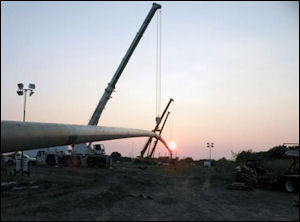by James A. Bacon
The developer of the 550-mile Atlantic Coast Pipeline wants to alter its proposed route between the West Virginia gas fields and markets in Virginia and North Carolina, reports the Richmond Times-Dispatch. Dominion Transmission Inc., leader of the company formed to build the pipeline, filed proposed route changes with federal regulators that would make greater use of existing rights of way, primarily Dominion-owned electric transmission lines.
The route changes partially address landowner criticism that the pipeline should run as much as possible along existing rights of way, be they state highways, electric transmission lines or other pipelines. But the changes submitted to the Federal Energy Regulatory Commission (FERC) are not likely to allay criticism from landowners in Augusta County and Nelson County where opposition to the pipeline is centered. The route changes would occur in Brunswick County, Southampton County and the City of Suffolk.
Foes told the Times-Dispatch that they were encouraged by Dominion’s effort to use existing rights of way, but… “Hopefully, this is a start, not a finish,” said Nancy Sorrells, co-chairwoman of the Augusta County Alliance and the All Pain, No Gain public relations campaign against the pipeline.
Dominion said the new proposed route would travel 16 miles of existing utility rights of way in Brunswick County, nine miles in Southampton, and seven miles in Suffolk.
Bacon’s bottom line: Routing pipelines is an incredibly complex undertaking. Pipeline projects are subject to intensive environmental review processes that consider impact on wildlife habitat, clean water and cultural & archaeological heritage. Running pipelines along existing rights of way saves considerable hassle as well as land acquisition costs.
“Utilities love to co-locate, if they can do it. You only have to deal with one landowner,” says James Kibler, senior vice president-external affairs for AGL Resources, an Atlanta-based gas pipeline company, one of the Atlantic Coast Pipeline’s four partners. Before joining AGL, Kibler conducted right-of-way acquisition work for Dominion.
As an example, Kibler says, the Virginia Natural Gas Crossing Pipeline, built in 2010 to connect the gas distribution systems north and south of Hampton Roads, utilized Dominion high-voltage transmission line right of way, drilled under an Old Dominion University parking lot, followed a City of Norfolk sewer lateral, and used six miles of Norfolk Southern rail line.
Trouble is, existing rights of way don’t always go where the pipeline needs to go, and the right of way may not be able to accommodate a pipeline. As the Times-Dispatch explained:
Dominion … said it is harder to route an underground pipeline along existing utility corridors in mountainous western Virginia than it is in the flat terrain of Southside.
“In the western part of the state, there’s just not a lot of opportunities there. There’s just not,” [said Greg Parks, construction supervisor].
Dominion spokesman Jim Norvelle said the company also is constrained by lack of space for a pipeline in existing public rights of way “because the pipeline cannot be built directly under electric transmission lines, on top of other pipelines, or alongside or in the median of highways, for safety reasons.”
Says Kibler: “It is a very involved, tedious process in which no one is ever totally happy.”



